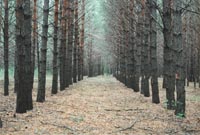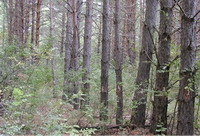|
|
УДК 630.5
PARTICULARITIES
OF GROWING AND SPRUCE STANDS
PHYTOMASS IN SOUTH URAL HIGHLAND (ON THE EXAMPLE OF MALII IREMEL HILL) Download PDF (159
KB)
Z.Ya. Nagimov1,
T.S. Babenko1,
I.G. Shevchenko1, I.V. Rahmanov1,
P.A. Moiseev2
1 Ural State
Forest-Technical University,
Ekaterinburg,
Russia
2 Institute of plants and
animals,
Ekaterinburg, Russia
Volume
XXIV,
Number 4-5, 2007
Abstract
There
were described associations of trees
heights and fractions of above and underground biomass in air-dry
condition
with their diameters, distribution of peculiarities of trees quantity
upon
their relative height on different altitudinal levels within 1210 and 1360 m
a. s. l. There were
determined actual reserves of the tree stands. The differences in the
growth
and structure of the stands linked with altitude were detected. The
average
diameter and average height of the stands regularly decrease with
altitude
increasing. The coefficient of variation of the heights varies within
17,2-38,2%,
but diameter - 26,3-66,8%. The average tree age greatly decreases with
altitude
increasing from 36 years on the profile top upon 95 years at the
bottom. Exists
the natural reduction of the forest density and crowding level of the
stands
with altitude increasing. On top-levels relationship of spruce tree
height and
diameter during all growing is expressed with direct line, but on lower
levels
this relationship curvilinear. This possibly explains that on
top-levels stands
are strongly rarefied and as the altitude decreases the forest density
and
crowding level of the stands are increase and, as effect, competitive
relations
between trees are increase too. With the lifting uphill the nature of
the
height change on step of the diameter and category of the heights are
change.
The maximum amount of the trees on all levels have a relative height
from 41
before 60. There are found multi-stem trees in the investigation area,
the
amount of which increases with altitude increasing. The total phytomass
of the
tree stands decreases with the lifting uphill from 182,3 tons/ha at the
bottom
levels to 3,4 tons/ha - on the top levels. In the investigation area
reduction
of this factor on each meter of the altitude is 1,19 tons/ha. In the
total
stands biomass share of the root systems is 20,6-30,0%.
References
- 1. Бабенко,
Т.С. Особенности хода роста деревьев ели
сибирской по объему на пределе ее распространения (Южный Урал, М.
Иремель) /
Т.С. Бабенко, З.Я. Нагимов, П.А. Моисеев // Леса Урала и хозяйство в
них. – Екатеринбург:
УГЛТУ. - 2006. - № 27.- С. 134-141.
- 2. Нагимов,
З.Я. Закономерности роста и формирования
надземной фитомассы сосновых древостоев: автореф. дис. …
д-ра с.-х. наук / З.Я.
Нагимов. -Екатеринбург: УГЛТУ, 2000.- 40 с.
- 3. Рокицкий,
А.В. Биологическая статистика / А.В. Рокицкий. -
Минск: Вышэйш школа, 1973. - 320 с.
- 4. Усольцев,
В.А. Моделирование структуры и динамики
фитомассы древостоев / В.А. Усольцев. – Красноярск: Наука,
1985. - 192 с.
- 5. Юкнис,
Р.А. Некоторые закономерности роста деревьев / Р.А.
Юкнис // Моделирование и контроль производительности древостоев -
Каунас: Академия,
1983. -С. 118 – 121.
___________________
|
|
|





